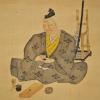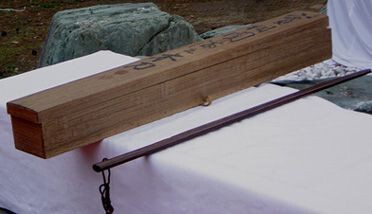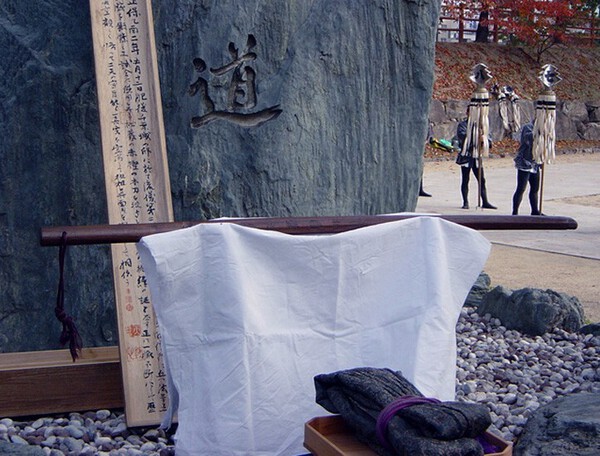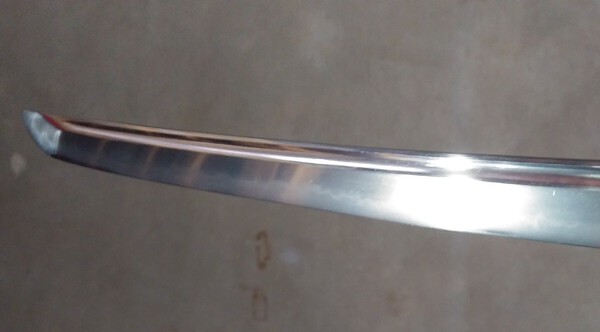-
Posts
143 -
Joined
-
Last visited
-
Days Won
1
Tim Evans last won the day on September 27 2018
Tim Evans had the most liked content!
Profile Information
-
Location:
Denver area USA
Profile Fields
-
Name
Tim E
Recent Profile Visitors
The recent visitors block is disabled and is not being shown to other users.
Tim Evans's Achievements
-

What makes a sword a masterpiece?
Tim Evans replied to Hoshi's topic in General Nihonto Related Discussion
I suspect Paul's Visions within Visions essay is not included. However, here is another example of his writing on nihonto aesthetics that is available online. https://jssus.org/1977V9_Bulletin.pdf It was found in the Japanese Sword Society of the United States Newsletter Archive. https://jssus.org/ -

Swords of the 47 Ronin
Tim Evans replied to Utopianarian's topic in General Nihonto Related Discussion
I pulled this off of a Japanese site years ago. "Musashi has many talent. He made sword fittings. Terao-Nobuyuki, Musashi's best pupil received a Musashi self-made koshirae. Sword is 81.8cm Kaneshige. Kashira is Hana-kukuri shape horn. kojiri is horn too. Fuchi is copper with hammer pattern. Tsuba is "Namako-sukashi" copper. Tsuka with horse leather Tsuka-ito". This sword is also described is the book, Zukan Toso no Subete on pages 58 and 59. The swordsmith is Izumi no Kami Fujiwara Kaneshige of Echizen. Also, there are two swords, a katana and wakizashi by Kawachi no Kami Nagakuni that are documented as being used by Miyamoto. Bokuto On the web page for the Hyoho Niten Ichi-ryu https://www.hyohonitenichiryu.com/global/english/ a bokuto made by Miyamoto called the Jisso Enman no Bokuto is mentioned. A detailed description is here https://www.hyoho.com/embo.html -

What makes a sword a masterpiece?
Tim Evans replied to Hoshi's topic in General Nihonto Related Discussion
Paul is a member of the Northern California Japanese Sword Club, and he and I have had very interesting conversations at their annual event, the San Francisco Token Kai. The last time I saw Paul was pre-Covid, but I believe he is still alive, he must be in his early 90's. He was a part of the Bob Haynes, Alan Harvie (deceased), and Keith Austin (AKA, the swordsmith NobuHira, also deceased) group of friends. John Yumoto was a mentor to members in the club, and opened doors to westerners seeking more knowledge in Japan. Two points: Paul describes that learning to see a good sword and developing a depth of vision is a never ending process that is best pursued with guidance from a more experienced person. He described this in the "Sensei Trouble: I Was Certain It Was A Trick" section, where Albert pointed out a section of kinsuji on a sword, but Paul could not see it or describe it. Albert said "you are not ready to see it yet" and put the sword away. Sometime later, the same sword was out for a different lesson and Paul saw the kinsuji, right where Albert said it was. Secondly, nihonto is a Japanese art form, and I tend to defer to what the Japanese prioritize as being more aesthetically important or in better taste (even though I may not understand why), rather than try to impose my own cultural ideas of what I find exciting or stimulating. This is one reason why as a tsuba collector, I prefer to study the mysteries of high quality iron tsuba (the aesthetics are very similar to nihonto) rather than chase the obviously pretty Edo period kinko, which to most kinko collectors, look like crude mud pies and therefore dismissed. -

What makes a sword a masterpiece?
Tim Evans replied to Hoshi's topic in General Nihonto Related Discussion
It is a wide ranging essay, so succinctly summarizing might be difficult. Below is a list of the topic headings that will provide an idea of the scope. Visions within Visions The Nature of Aesthetics and the Japanese Sword as Fine Art by Paul R. Allman Introduction: In Whose Eye is Beauty? The Sword as Beauty: How I first saw it. Is any Art Rubbish If no One Appreciates It? “Craft”, “Art” and the Sword: Some Definitions. Why Worry About It?: We Know the Sword is Art. What’s Ahead; A Summary View. The Avaricious Eye; Why do we collect? Money: The Lure of Mammon and the Love of Midas. “Collectibles”: The Search for Hidden Treasure. Self Identity Tools – Status Symbols: You are What You Own. Self-Expression; It’s Cheaper than Psychotherapy. The Weapon; Proof of Man’s Mastery. History; The Romance of Age and the Dreams of Past Life. Challenge: Technical Perfection and Esoteric Learning The Intellectual View: Idea and Icon. Appreciation: To Love an Object for Itself. “In Sum”: Conclusions About Collecting. Mind And Beauty: Theories of Aesthetics. Instrumental Or Pragmatic Views. Naturalistic Views. Formalist-Aesthetic Views. Theories of Aesthetic Vision Art and Language: the Shaky Tower of Blabber. Allman’s Theory of Pure Vision. Footnotes to Aesthetics: We’re Still in Trouble Art: What Is It?: One Man’s Eyes. Communication: The Ultimate Aesthetic Aim. Importance: The Expression of Primary Concerns. Display and Decoration: Symbols of Earthly Power. Celebration: The Art of Exuberance and Joy. Self Expression: Healing the Spirit Through Art. Art as Ordered Chaos: Man, The Order-Seeking Animal. Icons: Art as the Image of Supra-Earth States. The Touch of the “Kami”: Art and Supra-Earth Force. Harmony with the Tao; Art As Reflection of the Artist’s Being. Art as Seeing Shared; Do you See What I see? Art As A Good Time: The Effect of Time Spent Seeing. Looking to Find Vision: the Connoisseur As Artist. The Appreciator As A Man With Artist’s Eyes. Learning To See: The First Step Is the Hard One. Sensei Trouble: I Was Certain It Was A Trick. Hade, Hanayaka, Shibui; New Vision And New Words Too. Vision And Intellect: Friendly Enemies In Seeing Art. A Footnote On Vision: It Need Never Stop Growing. The Sword As Art: The Samurai As Aesthete. Baring and Beauty: Polishing As An Aesthetic Act. The Sword In History; Time Travel On An Art Object. Sword And Samurai; The Many Roles Of A Weapon As Art Object. The Kyoto Aesthetes; Balance To The Samurai. The Analytic Eye; Appraisal And Analysis, Then And Now. Factors In Appraisal: Some Basic Considerations. Schools Of Appraisal; Even Vision Changes. The Sword As Pure Object Today; The Aesthetics Of Now. The Sword As Sculpture; Form And Function…..And Beauty. The Sword As “Plastic Art”; The Interplay Of Form And Surface. The Collector’s Eye: Fear, Safety and Seeing. The Final Stroke: Perhaps An Empty Gesture. The Future: In The Jigane We See…? Does It Matter?: Then What Does? -

What makes a sword a masterpiece?
Tim Evans replied to Hoshi's topic in General Nihonto Related Discussion
Paul wrote a 37 page essay on the aesthetics of nihonto titled "Visions within Visions The Nature of Aesthetics and the Japanese Sword as Fine Art" for the 1976 Token Taikai Book of Lectures, and gave a lecture on the topic at that event. It may be possible to find a copy on the used book market. Paul is now retired, but was a regularly published art critic and studied nihonto with Albert Yamanaka. He proposed a range of aesthetic reactions: Catharsis Decoration Craft Low art Fine art High art He then makes the case that some nihonto does reach the level of High art. He relates his first encounter with a really good sword: "I felt a sense of shock from which I never recovered. Here was a thing of indescribable beauty that contained the idea of Kali, the creator destroyer; the ancient notion of the deadly phallus that creates; a symbol of purity; an icon of devotion; a thing of deep calm and incredible complexity that it seemed, even as I looked at it, to bring together a thousand loose ends of Man's thought and belief." In summary, High art, (which we may associate with the idea of a masterpiece) can elicit a profound emotional response. I think this aspect of the art of the sword goes beyond just being the best sword, or masterpiece, from a craft perspective (sugata, jigane, yakite), and broaches a spritual dimension. For example, Paul relates that Albert Yamanaka had the opinion: "Noda Hankei's arrogance was responsible for the blunt gracelessness of his shapes." This then enters the subjective realm of experience, sensitivity and taste, however I think there can be a consensus that some nihonto are at the High art, or masterpiece level. -
Chris, I added to my initial question above for more clarity. Maybe a US sword dealer can import some copies? I would prepay to reserve one.
-
Are there any estimates on what the tariff impact might be? i am asking after reading this import from Japan horror story in the General section. https://www.militaria.co.za/nmb/topic/53371-importing-nihonto-through-us-customs-and-tariff-info/ Some info on import duties https://www.shoppinginjapan.net/import-taxes-usa/ I also saw this statement. Japan Post announced it will temporarily suspend most U.S.-bound parcels, including gifts worth more than $100 and any items intended for sale. Letters, postcards, documents and small personal gifts under $100 will still be accepted, but larger or commercial shipments will need to go through private couriers such as DHL or UGX. So it looks to me like there are some new hoops to jump through to get a copy.
-

Large naginata auction on Yahoo Japan
Tim Evans replied to Gerry's topic in Auctions and Online Sales or Sellers
A question for Jussi, who seems to have direct experience with Hoju swords. I am assuming that the comments above are identifying the darker areas as shintetsu. Is that really shintetsu or something else, such as the namazu-hada sometimes seen on Aoe swords? The reason I ask is because I have a similar sword, papered to Hoju, that also has the light and dark areas. However, the dark areas are tighter grained and have nie, which does not follow the definition for shintetsu. I can post images if interested. -
Have a look at this thread. Tom Buttweiler's articles had information about how to identify and date menuki based on construction method, however, his interest was mostly in pre-Edo menuki. The Bushido articles are in the Downloads section. the 1976 Taikai article may be harder to find, but goes through Kokinko, Mino and Goto jidai menuki in detail. There are specialist books available that discuss Goto and Mino small fittings. For Edo period kinko, there are books that discuss specific artists and schools but will have a mix of tsuba, fuchi-gashira, kozuka, and menuki. Check Grey Doffin's site for what is available.
-
The hakogaki purports to be by Kanzan Sato, one of the founders of the NBTHK. There are other examples of his hakogaki that can be checked. If you are going to submit to NBTHK shinsa, then including the box is important. They would need to validate the box and then agree with the attribution. Some information on Hirata Hikoshiro here. Apparently several generations used this name. https://www.silk-road.us/hirata.html
-
Have a look at this thread for what Hirata shippo looks like. As Mauro mentioned, Hirata used iron, shakudo or copper base metals. Also, the cloissons are gold or silver with gold or sliver leaf inside. Some of the glass is transparent so the gold or silver shows through. The glass used is high quality pure colors, with few bubbles.
-
As requested, images of the sword. Length is 480mm, width at machi 24.5mm, thickness at machi 6mm. The sword is in old polish, so somewhat faded. Hamon is very white with a bright nioiguchi.
-
Uwe, thanks for the reference, I will add it to the others I have.
-
Wakizashi signed Noshu Seki Ju Kanesada. A Nosada or Koresada variant. Being primarily a tsuba guy, I do not have many sword references, so I am looking for opinions from those more knowledgeable than me if this one is gimei, or is it interesting enough to pursue shinsa? The sword otherwise has Mino Den characteristics. I am aware Nosada gimei is often encountered, so even though a long shot, I would like to check it out.
-
Sources - English Early Japanese Sword Guards (gold book) by Sasano Tsuba, an Aesthetic Study, by Robert Haynes Nihonto Koza Volume VI, Kodogu Part 1, translated to English by Harry Watson (rare) Sources - Japanese Owari To Mikawa no Tanko by Okamoto Yasukazu. 1983. Markus Sesko wrote an English translation. The fullest discussion of the Hoan school I am aware of. Short mentions or descriptions in Japanese tsuba books - One technique I have been using lately is Google Translate on a tablet, by holding the camera over a page in a Japanese book and then reading the text in English. This does a good job with newer books and printed kanji. This would work on the Koza mentioned above if you can only find the Japanese version. Bob Haynes mentioned to me there is a published Hoan geneology, if you can find one. Personally I would be somewhat sceptical of the claims.











